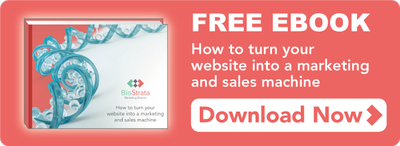First impressions matter. When we meet someone for the first time, we have judged them and formed an opinion about them within a few seconds. When it comes to your website visitors, they are doing exactly the same thing with your company. You have a matter of seconds to grab their attention, captivate them and encourage them to stay on your site. Bounce rate is the term used to quantify the percentage of people that enter a site, and then leave without navigating to any other page – most websites have a bounce rate of 30–60%. So, how do you go about improving this situation?
What Are First Time Visitors Looking For?
On visiting your website for the first time visitors will be asking themselves:
- Is this site credible?
- Is it trustworthy?
- Is this a professional company?
- Is this company stable?
- Does this site make me feel welcome?
- Am I in the right place?
Your life science website design should represent who you are and what you offer while providing reassurance that web users are in the right place and yours is a company they would be prepared to do business with.
Consumers Judge on Aesthetics
As with meeting a person for the first time, the appearance of a website will be the primary factor responsible for forming an opinion. An in-depth study from the Stanford University and Consumer Web Watch entitled ‘How Do People Evaluate a Website’s Credibility? Results from a Large Study’ found that a website’s design was more important than credibility indicators such as having a privacy policy, awards or certificates. So while consumers may say the first indicator they judge on is substance, the reality is that they judge on aesthetics. Therefore, if your website fails to deliver on design it is likely the visitor will become a bounce rate statistic and instantly leave.
So, how do we go about developing a great life science website with a low bounce rate?
Tips for Great Website Design
- Proper use of colours. Use colour to grab visitors’ attention. If you take the healthcare sector for example, you will see a leaning towards blue-based colour palettes. Therefore, if you are entering the healthcare arena, you may want to consider branding that contrasts with the competition to make you stand out.
- Avoid anything unnecessary. More and more of us are searching the internet on our smart phones, many of which do not support Flash animation. Therefore it is better to just keep it simple.
- Layout. Create a clear navigation structure and organise page elements in a grid fashion.
- Typography. Make sure your website is legible by using fonts, font sizes and colour that are easy to read. For easier page scanning make use of bullet points, section headers and short paragraphs.
These tips will help you to reduce bounce rates on your website and make a memorable first impression. But remember, while a well-designed website is important for convincing visitors to take a closer look, they won’t look twice if the content isn’t useful and well organised.
You can find out more about life science website development, design and content by downloading our FREE eBook on turning your website into a marketing and sales machine.





